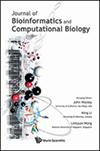结合硅片-体外合理设计致癌egfr衍生的特异性单克隆抗体结合肽模位。
IF 0.7
4区 生物学
Q4 MATHEMATICAL & COMPUTATIONAL BIOLOGY
Journal of Bioinformatics and Computational Biology
Pub Date : 2023-04-01
DOI:10.1142/S0219720023500075
引用次数: 1
摘要
人表皮生长因子受体(EGFR)与恶性肿瘤增殖密切相关,已被确定为多种癌症的治疗靶点,并被用作肿瘤诊断的重要生物标志物。在过去的几十年里,已经成功开发了多种单克隆抗体(mab)来特异性识别EGFR细胞外结构域的第三亚结构域(TSD)。本研究对EGFR TSD亚域及其同源单抗的复杂晶体结构进行了系统的检测和比较,揭示了这些单抗具有一致的结合模式。识别位点位于TSD阶梯结构的[公式:见文本]-sheet表面,从中鉴定出几个显著赋予识别稳定性和特异性的热点残基,约占单克隆抗体与TSD亚结构域总结合效力的一半。利用正交穿链(OTTS)策略,合理设计了许多线性肽模位,以不同的方向和/或不同的头尾方式模拟这些TSD热点残基,但这些残基在自由状态下本质上是无序的,因此无法保持原生热点样构象。采用化学钉接策略,通过在肽模位的两条链臂上引入二硫键,将游离肽约束为双链构象。经验评分和[公式:见文]荧光分析均一致认为,钉接能有效提高ots设计的肽模位与不同单克隆抗体的相互作用效力,结合亲和力提高了[公式:见文]1倍。构象分析表明,钉接的环肽模位可以自发折叠成双链构象,很好地穿过TSD[公式:见文]-片表面的所有热点残基,并与TSD热点位点与单克隆抗体的结合模式一致。本文章由计算机程序翻译,如有差异,请以英文原文为准。
Integrated in silico-in vitro rational design of oncogenic EGFR-derived specific monoclonal antibody-binding peptide mimotopes.
Human epidermal growth factor receptor (EGFR) is strongly associated with malignant proliferation and has been established as an attractive therapeutic target of diverse cancers and used as a significant biomarker for tumor diagnosis. Over the past decades, a variety of monoclonal antibodies (mAbs) have been successfully developed to specifically recognize the third subdomain (TSD) of EGFR extracellular domain. Here, the complex crystal structures of EGFR TSD subdomain with its cognate mAbs were examined and compared systematically, revealing a consistent binding mode shared by these mAbs. The recognition site is located on the [Formula: see text]-sheet surface of TSD ladder architecture, from which several hotspot residues that significantly confer both stability and specificity to the recognition were identified, responsible for about half of the total binding potency of mAbs to TSD subdomain. A number of linear peptide mimotopes were rationally designed to mimic these TSD hotspot residues in different orientations and/or in different head-to-tail manners by using an orthogonal threading-through-strand (OTTS) strategy, which, however, are intrinsically disordered in Free State and thus cannot be maintained in a native hotspot-like conformation. A chemical stapling strategy was employed to constrain the free peptides into a double-stranded conformation by introducing a disulfide bond across two strand arms of the peptide mimotopes. Both empirical scoring and [Formula: see text]fluorescence assay reached an agreement that the stapling can effectively improve the interaction potency of OTTS-designed peptide mimotopes to different mAbs, with binding affinity increase by [Formula: see text]-fold. Conformational analysis revealed that the stapled cyclic peptide mimotopes can spontaneously fold into a double-stranded conformation that well threads through all the hotspot residues on TSD [Formula: see text]-sheet surface and exhibits a consistent binding mode with the TSD hotspot site to mAbs.
求助全文
通过发布文献求助,成功后即可免费获取论文全文。
去求助
来源期刊

Journal of Bioinformatics and Computational Biology
MATHEMATICAL & COMPUTATIONAL BIOLOGY-
CiteScore
2.10
自引率
0.00%
发文量
57
期刊介绍:
The Journal of Bioinformatics and Computational Biology aims to publish high quality, original research articles, expository tutorial papers and review papers as well as short, critical comments on technical issues associated with the analysis of cellular information.
The research papers will be technical presentations of new assertions, discoveries and tools, intended for a narrower specialist community. The tutorials, reviews and critical commentary will be targeted at a broader readership of biologists who are interested in using computers but are not knowledgeable about scientific computing, and equally, computer scientists who have an interest in biology but are not familiar with current thrusts nor the language of biology. Such carefully chosen tutorials and articles should greatly accelerate the rate of entry of these new creative scientists into the field.
 求助内容:
求助内容: 应助结果提醒方式:
应助结果提醒方式:


